
Concept explainers
(a)
The degree of the polynomial function that represents the graph.
(a)
Answer to Problem 118E
The degree of the polynomial is 3.
Explanation of Solution
Given information:
The graph is shown below as,
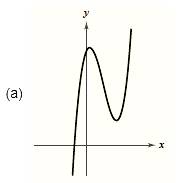
Formula used:
The leading coefficient is used.
Calculation:
Consider the following graph
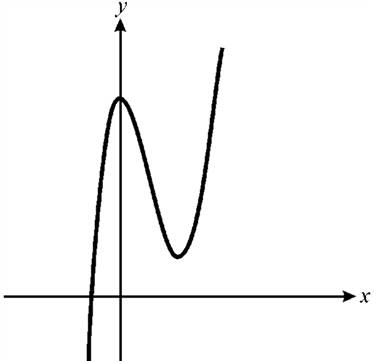
Since the graph rises to right and falls to the left, hence the leading coefficient is negative and degree of the polynomial is odd.
From the above it is clear that the graph has only one root. Since the graph crosses the x-axis, hence this root has odd multiplicity.
Also the graph has two turns; hence the degree of the polynomial is 3.
Conclusion:
The degree of the polynomial is 3.
(b)
To find: The degree of the polynomial function that represents the graph.
(b)
Answer to Problem 118E
The degree of the polynomial is 2.
Explanation of Solution
Given information:
The graph is given as,
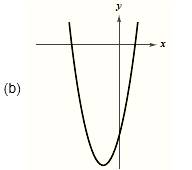
Formula used:
The leading coefficient is used.
Calculation:
Since the graph rises to right and to the left, hence the leading coefficient is positive and degree of the polynomial is even.
From the above it is clear that the graph has two roots. Since the graph crosses the x-axis, hence these roots have odd multiplicity.
Also the graph has one turn; hence the degree of the polynomial is 2.
Conclusion:
The degree of the polynomial is 2.
(c)
To find: The degree of the polynomial function that represents the graph.
(c)
Answer to Problem 118E
The degree of the polynomial is 4.
Explanation of Solution
Given information:
The graph is given as,
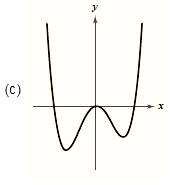
Formula used:
The leading coefficient is used.
Calculation:
Consider the following graph
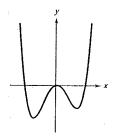
Since the graph rises to right and to the left, hence the leading coefficient is positive and degree of the polynomial is even.
From the above it is clear that the graph has three roots. Since the graph crosses the x-axis at two points, hence these roots have odd multiplicity. The graph touches the x-axis at one point hence this root has even multiplicity.
Also the graph has three turns; hence the degree of the polynomial is 4.
Conclusion:
The degree of the polynomial is 4.
(d)
To find: The degree of the polynomial function that represents the graph.
(d)
Answer to Problem 118E
The degree of the polynomial is 5.
Explanation of Solution
Given information:
The graph is given as,
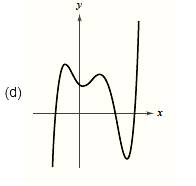
Formula used:
The leading coefficient is used.
Calculation:
Consider the following graph
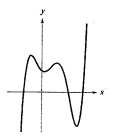
Since the graph rises to right and falls to the left, hence the leading coefficient is negative and degree of the polynomial is odd.
From the above it is clear that the graph has three roots. Since the graph crosses the x-axis at three points, hence these roots have odd multiplicity. Also the graph has four turns; hence the degree of the polynomial is 5.
Conclusion:
The degree of the polynomial is 5.
Chapter 2 Solutions
EP PRECALC.GRAPHING APPR.-WEBASSIGN-1YR
 Calculus: Early TranscendentalsCalculusISBN:9781285741550Author:James StewartPublisher:Cengage Learning
Calculus: Early TranscendentalsCalculusISBN:9781285741550Author:James StewartPublisher:Cengage Learning Thomas' Calculus (14th Edition)CalculusISBN:9780134438986Author:Joel R. Hass, Christopher E. Heil, Maurice D. WeirPublisher:PEARSON
Thomas' Calculus (14th Edition)CalculusISBN:9780134438986Author:Joel R. Hass, Christopher E. Heil, Maurice D. WeirPublisher:PEARSON Calculus: Early Transcendentals (3rd Edition)CalculusISBN:9780134763644Author:William L. Briggs, Lyle Cochran, Bernard Gillett, Eric SchulzPublisher:PEARSON
Calculus: Early Transcendentals (3rd Edition)CalculusISBN:9780134763644Author:William L. Briggs, Lyle Cochran, Bernard Gillett, Eric SchulzPublisher:PEARSON Calculus: Early TranscendentalsCalculusISBN:9781319050740Author:Jon Rogawski, Colin Adams, Robert FranzosaPublisher:W. H. Freeman
Calculus: Early TranscendentalsCalculusISBN:9781319050740Author:Jon Rogawski, Colin Adams, Robert FranzosaPublisher:W. H. Freeman
 Calculus: Early Transcendental FunctionsCalculusISBN:9781337552516Author:Ron Larson, Bruce H. EdwardsPublisher:Cengage Learning
Calculus: Early Transcendental FunctionsCalculusISBN:9781337552516Author:Ron Larson, Bruce H. EdwardsPublisher:Cengage Learning





